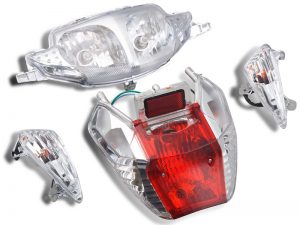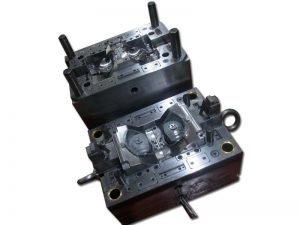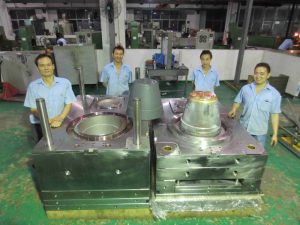Plastic Molding

The tools and products we use in daily life range from the base of the machine tool, the outer casing of the machine to a small screw, button, and case of various household appliances, all of which have a close relationship with molding. The shape of the mold determines the form of these products, and the quality and precision of molding determine the quality of these products. Because of various products’ different materials, appearance, specifications, and uses, molding is divided into casting molds, forging dies, die-casting dies, stamping dies, other non-plastic molds, and plastic molds. In recent years, with the rapid development of the plastics industry and continuous improvement of strength and precision of general and engineering plastics, the application range of plastic products is also expanding, such as household appliances mold, instrumentation mold, construction equipment mold, automotive mold. The proportion of plastic products is increasing rapidly. A well-designed plastic part can often replace multiple traditional metal parts. The trend of plasticization of industrial products and daily-use products is on the rise.
Mold design and manufacturing are closely related to plastic processing. The success or failure of plastic processing depends mainly on the mold design effect and mold manufacturing quality. In contrast, the plastic mold design is based on the correct plastic product design.
Structural elements to be considered in the design of plastic mold are: the
1, Parting surface. That is a contact surface where concave and convex cooperate when closed molding. The choice of its position and form is influenced by product shape and appearance, wall thickness, forming method, post-processing process, molding type and structure, demolding method, and molding machine structure.
2, Structural parts. Sliders, inclined tops, and straight top blocks of complex molding. The design of structural elements is critical, related to the life of the mold, processing cycle, cost, quality of product, etc. Therefore, it has higher requirements for the designer’s comprehensive ability to design complex mold core structures, pursuing as simple as possible, durable, and economical.
3, Mold accuracy. That is fine positioning, guide columns, positioning pins, etc. The positioning system is related to the appearance quality of the product, the quality, and the life of molding. According to different mold structures, other positioning methods are selected. The positioning precision control mainly depends on the processing. The internal mold positioning is primarily for a more proper and adjustable positioning that designers must fully consider.
4, Pouring system. The feeding channel from the nozzle of the injection molding machine to the cavity, including the main drain, runner, gate, and cold hole. In particular, the location of the entrance should be selected to facilitate the filling of molten plastic in a well-flowing cavity. The solid-state flow path and gate cold material attached to the product are quickly ejected from molding and removed during mold opening (except for hot runner mold).
5, Plastic shrinkage and various factors affecting the dimensional accuracy of the product, such as mold manufacturing and assembly errors, molding wear, etc. In addition, when designing compression molding and injection molding, matching the process and structural parameters of the molding machine should also be considered. Computer-aided design techniques have been widely used in plastic molding design.

The gating system refers to the part of the flow path before plastic enters the cavity from the nozzle, including the main channel, cold material hole, shunt channel, and gate. Molded parts refer to various components that make up the product’s shape, including moving molds, fixed molds and cavities, cores, forming rods, and exhaust ports.
In Have Mould, which has 20 years of production experience in injection mold, we will meet the needs of customers with more stringent requirements:
- Higher mold accuracy
With the continuous improvement of living and production levels, requirements for product structure are also constantly increasing, which requires molding have a higher ornamental and more sophisticated functional design. Traditional mold processing method has a high dependence on the operator’s technology, use of various tools, and complex, and the processing cycle is relatively long, which can not meet the requirements of plastic molding manufacturing. Therefore, high-precision three-dimensional structural molding will become a new growth demand point, and we will be in the direction of precision, three-dimensional, high-efficiency, and rapid.
- Higher plastic molding life
The life of plastic molding is an essential molding parameter related to the product’s quality and overall cost. At present, the service life of molding is above 1 million plastic cycles. Imported steel with a higher rate will be selected for higher requirements, while material and processing costs will also increase accordingly.
- Shorter Mold manufacturing cycle
The current market is fiercely competitive, and the speed of product replacement is fast. Making products appear quicker and better in front of consumers is the key to success. Therefore, the product must be controlled from the design to the finished product in a brief period; many products are assembled from various structures and material combinations, often requiring plastic parts to be designed and efficiently formed quickly. As a result, a shortened manufacturing cycle of the plastic mold and higher production processes and efficiency are required to meet the total production demand.
- More clear design and manufacturing division of labor
A detailed and professional form of cooperation in designing and manufacturing plastic molds has been formed in China. When customers put forward product requirements, Have Mold R&D team proposes a design plan after 3D modeling. After the solution is determined, Our engineers will carry out mold manufacturing. Finally, the finished mold will be transferred to the injection department for plastic production or customers. These links have been specialized, scaled, and completed through a professional team, and manufacturing features are geographically differentiated and more detailed.
- Factory will develop into a specialized segmentation
Plastic molds usually only need to manufacture one or several sets to meet production requirements. They are produced in single products, but many accessories make up the mold. From the most extensive mold base to the most miniature thimble, each one Accessories must affect the final product quality, so the quality of each accessory must meet very high precision and quality requirements. At Have Mould, subdivision requirements and accessories specialization have been improved. Only by focusing on professionalism can we produce higher quality products.
In recent years, plastic molding development in China has been quite fast. Plastic molds account for about 30% of the entire mold industry. With the rapid growth of China’s automotive mold, home appliances mold, electronic communications mold, and various building materials, it is expected that in the future mold market, the proportion of plastic mold in total molding will gradually increase, and the development speed will be faster than other molds. Taking the automotive industry as an example, with the rapid growth of automobile production and sales, the potential market for automotive molding is enormous. According to reports, all functional parts must be molded by molding in automotive production. More than 200 pieces of interior features mold needed to make an average car. At the same time, large and medium-sized plastic molds such as bumper molds, instrument panel molds, fuel tank molds, and steering wheel molds currently meet about 50% of the production capacity of the molding industry. In construction, replacing traditional materials with plastic building materials is also a general trend. It is expected that the penetration rate of plastic doors and windows and plastic pipes in China will reach 40% to 60%, and the market share of plastic drainage pipes will exceed 60%, which will significantly increase the demand for molding. It should be said that the application potential of plastic molding cannot be underestimated. Experts predict large, precise, and the market will widely welcome well-designed injection molds.

1, The increasing size of mold-forming parts and high productivity of parts require multiple cavities, resulting in more extensive mold. Large-scale molds with large tonnage can reach 100 tons, and a few hundred holes and thousands of holes require mold processing equipment. Large workbench, increased y-axis z-axis travel, large load-bearing, high rigidity, high consistency.
2, Mold steel material processed by molding has high hardness, and mold processing equipment must have thermal stability and reliability.
3, For complex cavity and multi-functional composite mold, with the complexity of the shape of the workpiece, it is necessary to improve the design and manufacture level of decay. A variety of grooves and materials are formed or assembled into a set of molds. Functional composite molds require many machining programming procedures, high cutting depth and stability, and high processing difficulty.
4, It will be more attractive to make the compounding and high efficiency of processing equipment through the refinement of mold processing. High-speed milling has many advantages, such as high-hardness materials that can be processed, smooth processing, small cutting force, and slight temperature rise and deformation of the workpiece, which makes mold companies pay more and more attention to high-speed machining.
5, High dynamic accuracy. The static performance introduced by the machine tool manufacturer did not reflect the actual machining situation when three-dimensionally machined molding. High-precision machining of the three-dimensional surface of molding also requires high dynamic precision performance, high-speed and high-precision matching, high rigidity, thermal stability, high reliability, and a high-quality control system of the machine tool.
6, The popularization of mold integrated manufacturing unit and its technology. In addition that molding has the functions of automatic feeding, stamping forming, lamination metering, thickness grouping, iron core combination, and product output, hinge assembly connection. Complex motion structure, in-mold heating, Forging, local heat (tissue) control, in-mold welding, tapping, partial injection molding, in-mold cutting, in-mold testing, and other process combinations also appeared in molding. New technologies such as internal hot die-cutting of plastic and boron steel sheets and variable edge cutting of motor pen-shaped iron cores have created a new era of integrated mold manufacturing units. Mold products continue to develop in the direction of enormous, sophisticated, high-performance, integrated manufacturing units.
8, Wide application of 3D printing in mold manufacturing. 3D printing application production mold cavity is a new trend in the development of cavity mold. The metal additive-reduced material combination manufacturing technology is an essential direction in 3D printing. At present, high-precision manufacturing of complex metal parts is realized by 3D layer-by-layer additive forming, combined with high-speed milling of layer thickness profile and material reduction.
9, The intelligentization of the mold. The plastic molding and die-casting mold industry have presented some kinds of molds that can intelligently control cavity pressure, temperature, flow, and cooling process. In addition, the intelligence of mold processing equipment is also rapidly advancing intelligent manufacturing of mold.
10, Lightweight new materials, presentation, and optimization of large-scale plastic molds. With the development of lightweight vehicles, new lightweight materials emerge in an endless stream. China mold factories have begun to cope with this change and have launched lightweight new materials for car cover mold and large-scale development of composite data mold.
11, Maturity of large-scale progressive die technology, high speed, and high reliability has become an essential feature of the fine-level progressive die. Currently, large-scale developed stamping parts are everywhere; parts are getting larger and larger, and shapes are more and more complex, showing large-scale advanced die technology has entered the mature stage. The high-precision precision progressive die has higher and higher requirements for stability and reliability of production and has become a necessary means of competition for mold manufacturing enterprises. Mold design and manufacturing technology of super large-sized formed parts and small ultra-precision pieces has become a hot spot for molding factories.
12, Mold standard parts tend to be refined. With improved mold types and requirements in recent years, mold standard parts have become essential for mold companies to participate in international competitions. The variety and classification are the main trends of current mold standard parts. More and more traditional standard parts are increasing, and quality requirements are increasing. New functional structure standard parts with more manufacturing flexibility are becoming increasingly important, becoming a new direction for new technologies and innovations to enhance competitiveness.
